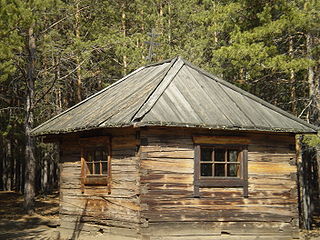Semeiskie
- Do not translate text that appears unreliable or low-quality. If possible, verify the text with references provided in the foreign-language article.
- You must provide copyright attribution in the edit summary accompanying your translation by providing an interlanguage link to the source of your translation. A model attribution edit summary is
Content in this edit is translated from the existing Bashkir Wikipedia article at [[:ba:Семейҙар]]; see its history for attribution. - You may also add the template
{{Translated|ba|Семейҙар}}to the talk page. - For more guidance, see Wikipedia:Translation.

The Semeiskie are a community of orthodox Old Believers who have lived in the Transbaikal since the reign of Catherine the Great.[1] The sacred rites and rituals of the Old Believers came to be in opposition to those of the official state church after the introduction of the 17th century religious reforms known as the Raskol. Those who rejected the reforms became known as "Old Believers" and continued to practice their faith despite repression. The Semeiskie were a particular group of Old Believers who fled to Gomel in Belarus (at that time part of Poland).[1] Catherine the Great then exiled the group to Buryatia, on the pretext that they could there become farmers for the Cossack guards who defended the borders of the empire. The descendants of these original Semeiskie have lived in the region ever since.
Culture
The Semeiskie have a long oral tradition, in speech[2] as well as vocal music. The Semeiskie songs are notable for their polyphonic dissonance[3] in both sacred and secular music. The themes of the songs vary widely, from religious texts to everyday songs.[3] The cultural space and oral culture of the Semeiskie was placed on the UNESCO List of the Intangible Cultural Heritage of Humanity in 2001.[4]
References
- ^ a b Lambroschini, Sophie (December 1, 2003). "Russia: Old Believers Struggle To Keep The Faith Amid Isolation". Radio Free Europe/Radio Liberty.
- ^ Kliauz, Vladimir (2001). "Video-Recording Ritual Incantations and Folk Cures". SEEFA. VI (2). Translated by James Bailey: 28–34.
- ^ a b Dorofeev, N.I. (1989). Russkie narodnye pesni Zabaikal'ia: semeiskii raspev. Moscow.
{{cite book}}: CS1 maint: location missing publisher (link) - ^ "Cultural space and oral culture of the Semeiskie". UNESCO. Retrieved 25 April 2012.
- v
- t
- e
- Anastenaria
- Bistritsa Babi
- Busójárás
- Căluşari
- Doina
- Falconry
- Fujara
- Hlinecko Shrovetide
- Ride of the Kings
- Rite of the Kalyady Tsars
- Semeiskie
- Táncház
- Verbunkos











